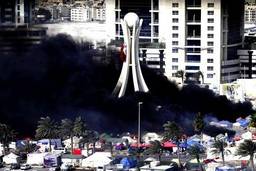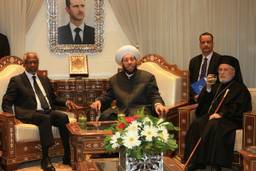By David Szydloski
It has been a little more than week since the United Nations Security Counsel passed Resolution 1973—which authorized member states to “take all necessary means to protect civilians and civilian populated areas under threat of attack” in Libya—and less than a week since the US launched Operation Odyssey Dawn as part of a larger NATO operation to implement a no-fly zone and weapons embargo to stop pro-Ghaddafi forces.
Reading through the many articles, posts, and opinions about US intervention in Libya in the past week, three questions kept coming back to me that were either missing from the conversation or a little difficult to answer.
1. What is the Legal Framework for US intervention in Libya?
The War Powers Resolution of 1973 (in no way connected with the current UN Security Counsel Resolution 1973) allows the president to commit armed forces to military action for 60 days (and another 30 days to withdraw those forces) and requires the president to notify Congress within 48 hours of this decision, which President Obama did in his March 21 letter. In the letter, the president indicated that he acted “pursuant to my constitutional authority to conduct U.S. foreign relations and as Commander in Chief and Chief Executive.” He also invoked Resolution 1973 and the actions of NATO member states to provide added legitimacy for his decision.
The timing of Obama’s actions has raised some concern. Even though the UN, the US and NATO have been discussing a no-fly zone since at least early March, Obama’s decision to act was made on March 19th, one day after Congress began its week-long recess—removing the possibility of any legislation for or against his decision.
There is already a lot of talk about what will happen when Congress is back in session on Monday. Some in Congress have voiced their support for legislation that would retroactively provide legislative authorization for Odyssey Dawn. Others, like Senators Congressmen Dennis Kucinich and Ron Paul, are already claiming that Obama's actions constitute an "impeachable offense"--though this already might have changed.
2. How much is Odyssey Dawn costing the US?
In our current climate of "tough but necessary" fiscal austerity, you'd think the first question publicly discussed would concern the cost of possible intervention.
Estimates on the total cost of Odyssey Dawn vary—and military budgeting is notoriously complicated. Here's a breakdown of some of the costs from Stars and Stripes:
The Department of Defense has yet to release an overall estimate, but Tomahawk cruise missiles, which were fired in a massive fusillade to begin the attack and have been sent after targets scores of times since, cost between $700,000 and $1 million each, depending on their capabilities. As of Tuesday, 161 had been fired, said Adm. Samuel J. Locklear III, commander of Naval Forces Europe and Naval Forces Africa.
…
A Marine V-22 Osprey flew from the USS Kearsarge to rescue one of the pilots from an Air Force F-15E Strike Eagle that crashed Tuesday due to mechanical errors. Both pilots survived, but the jet was reduced to little more than a pile of tangled metal, picked through by dozens of Libyans in a small village east of Benghazi. Valued by the Air Force at $31.1 million in 1998 dollars, the F-15 would be worth more than $40 million in today’s figures.
Long-term costs are the topic of a recent (and oft quoted) paper from the Center of Strategic and Budgetary Assessments. The paper describes three possible types of no-fly zones and their associated costs. A no-fly zone over all of Libya could cost between $100 to $300 million a week, a no-fly zone only north of the 29 parallel—between $30 to $100 million, and a "Standoff" no-fly zone—which would only cover hot spots near the coast—$15 to $25 million a week. However, some sources are already saying that the US is currently paying $100 million per day.
Right now, the operation has been run using the Pentagon's existing funds, but additional funds from Congress could be needed in the near future.
3. How Much, if any, Arms or Training Did Ghaddafi Get From His Enemies?
In 2003, Ghaddafi announced that he would give up his weapons of mass destruction. For many commentators it was a sure sign that the “Shock and Awe” of Operation Iraqi Freedom was working to deter other leaders hostile to the U.S. or its allies from developing nuclear, chemical or biological weapons. The US and EU lifted its arms embargoes soon after.
It's a (sadly) predictable irony that now many of the countries bombing and blockading Libya, had—even very recently—sold Ghaddafi weapons and trained his soldiers. England, France, Belgium, Italy and the US are all guilty of this. Ghaddafi particularly got chummy with Silvio Berlusconi, whom the Libyan leader promised to help stop immigration from Africa (through Libya) to Italy because, without Libya’s help, Europe would turn “black”.
Correction (March 26, 2011)
The previous draft of this post incorrectly said that Ron Paul and Dennis Kucinich were Senators when they are in fact members of the House of Representatives.
Please consider supporting our work.

I hope you found this article important. Before you leave, I want to ask you to consider supporting our work with a donation. In These Times needs readers like you to help sustain our mission. We don’t depend on—or want—corporate advertising or deep-pocketed billionaires to fund our journalism. We’re supported by you, the reader, so we can focus on covering the issues that matter most to the progressive movement without fear or compromise.
Our work isn’t hidden behind a paywall because of people like you who support our journalism. We want to keep it that way. If you value the work we do and the movements we cover, please consider donating to In These Times.



